Removal Efficiency of an Aluminum Based Hydrotalcite-Like-Compound on Arsenic
Hydrotalcite has been considered as a promised adsorbent to remove arsenic. In this study, bench scale
studies were conducted to evaluate the effects of adsorbent dose and initial pH on the efficiency for
removing arsenic (As)(III) and As(V) by adsorption onto an Al-based hydrotalcite (named MA3). Then the
maximum removal adsorption capacity and isothermal models were investigated. The results showed that
the optimum pH values for removing As(III) and As(V) were 10 and 5-6, respectively. The investigated MA3
were capable of removing As(III) and As(V) at maximum capacity of 0.14 and 21.9 mg/g, respectively at
25 oC and optimum pH. Langmuir isotherm model was better fitted to invested data than Freundlich isotherm
model for both As(III) and As(V) with R2 value of 0.93 and 0.99, respectively. It is implied that the adsorption
mechanisms were closed with monolayer adsorption
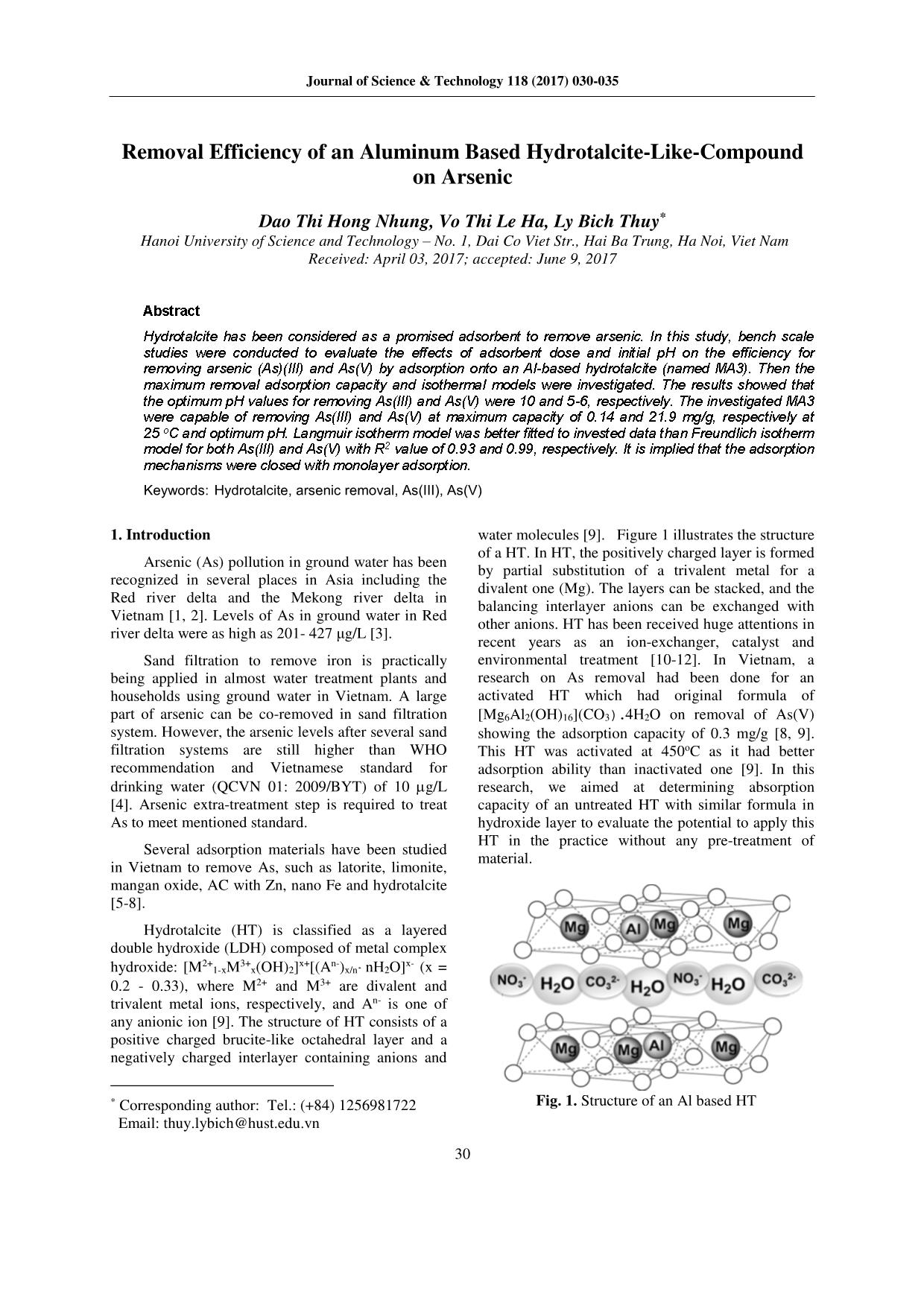
Trang 1
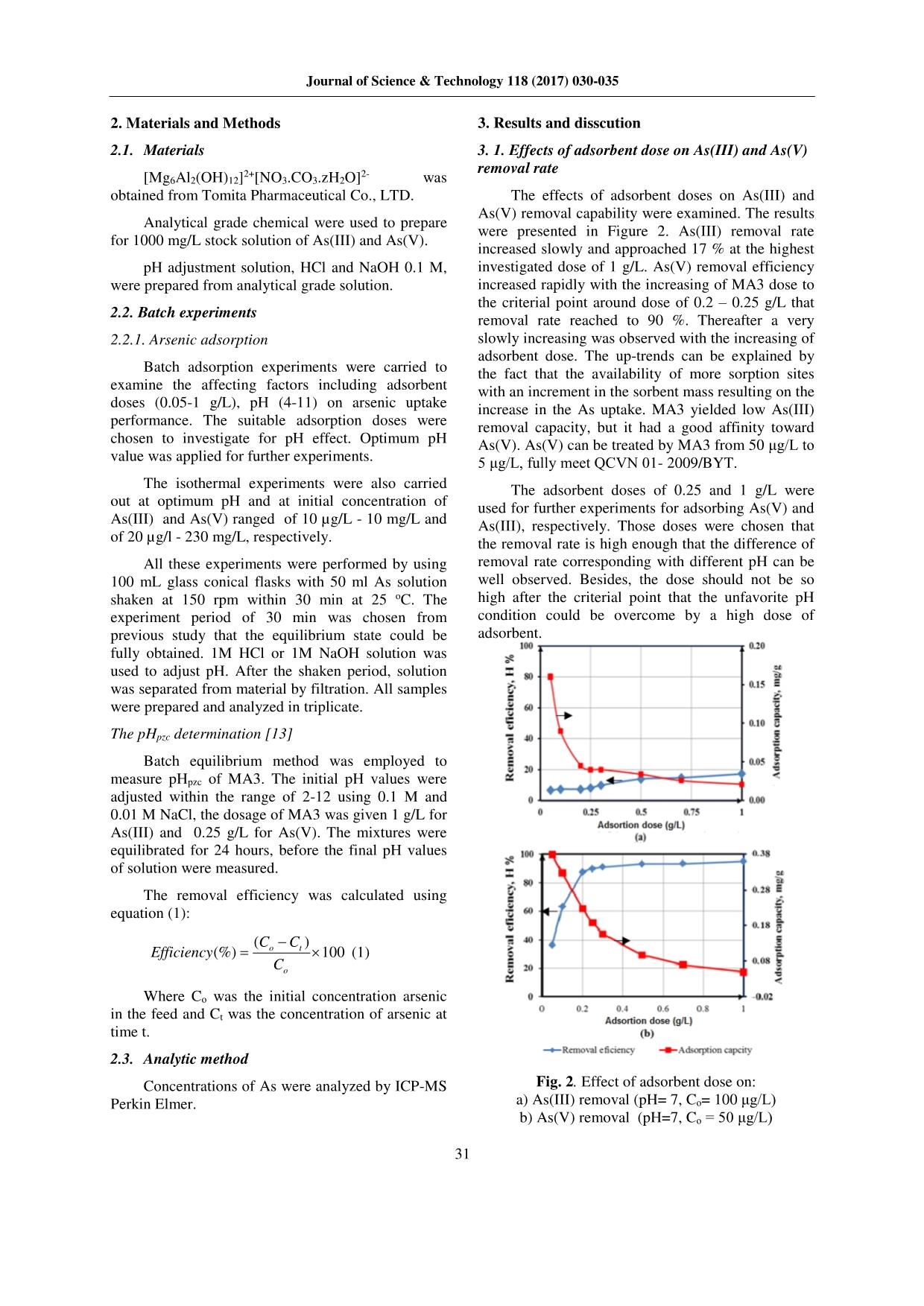
Trang 2
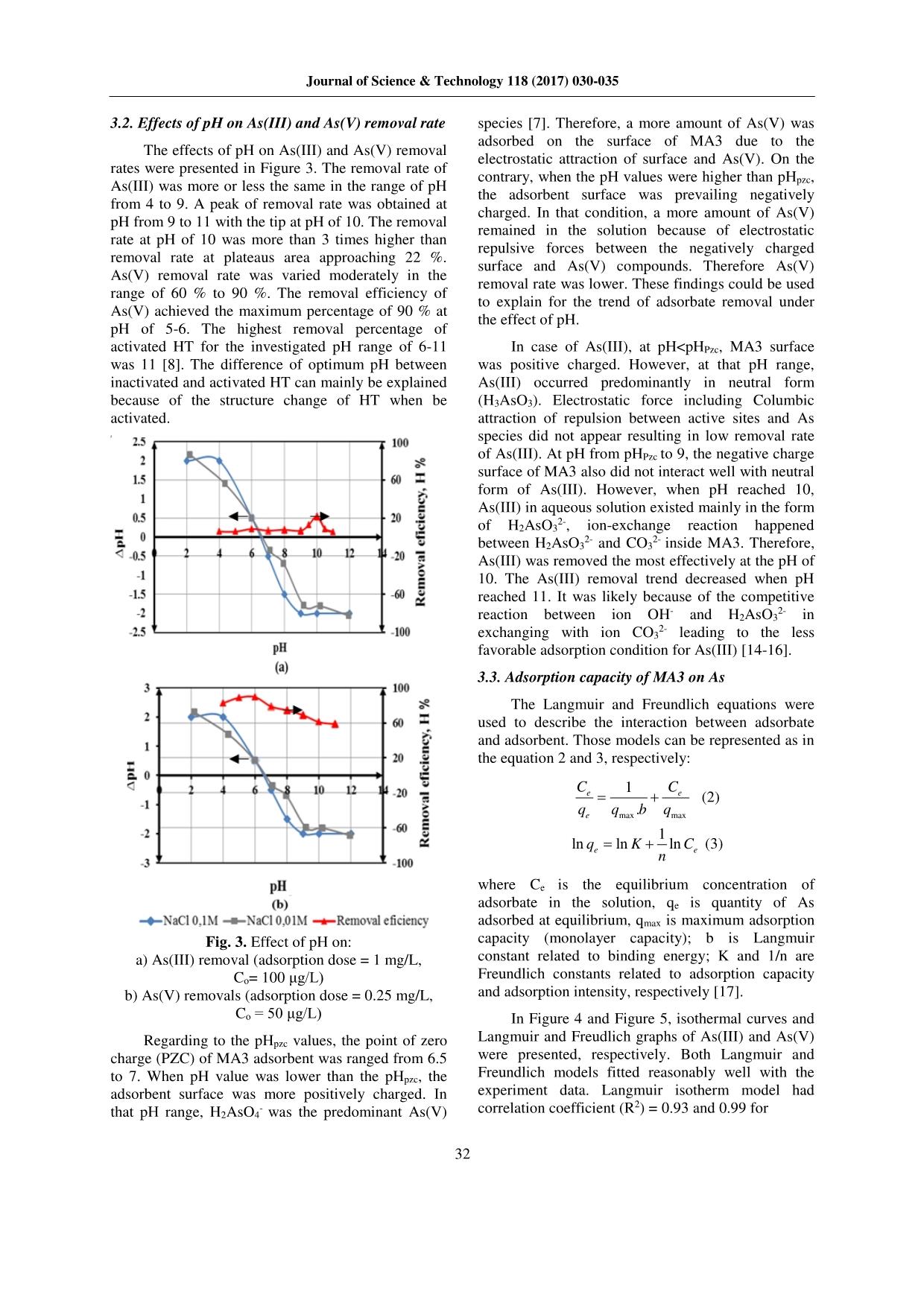
Trang 3
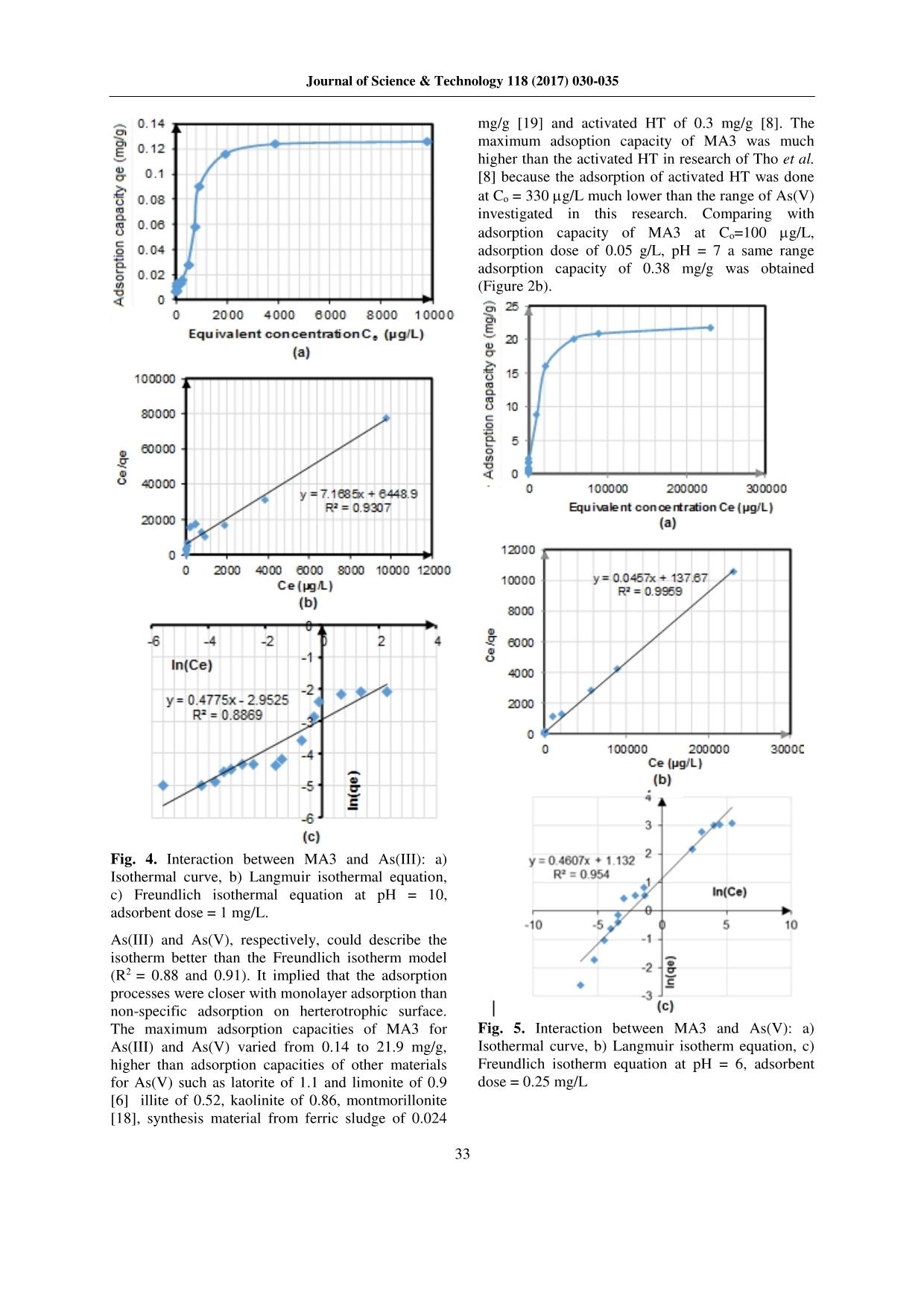
Trang 4
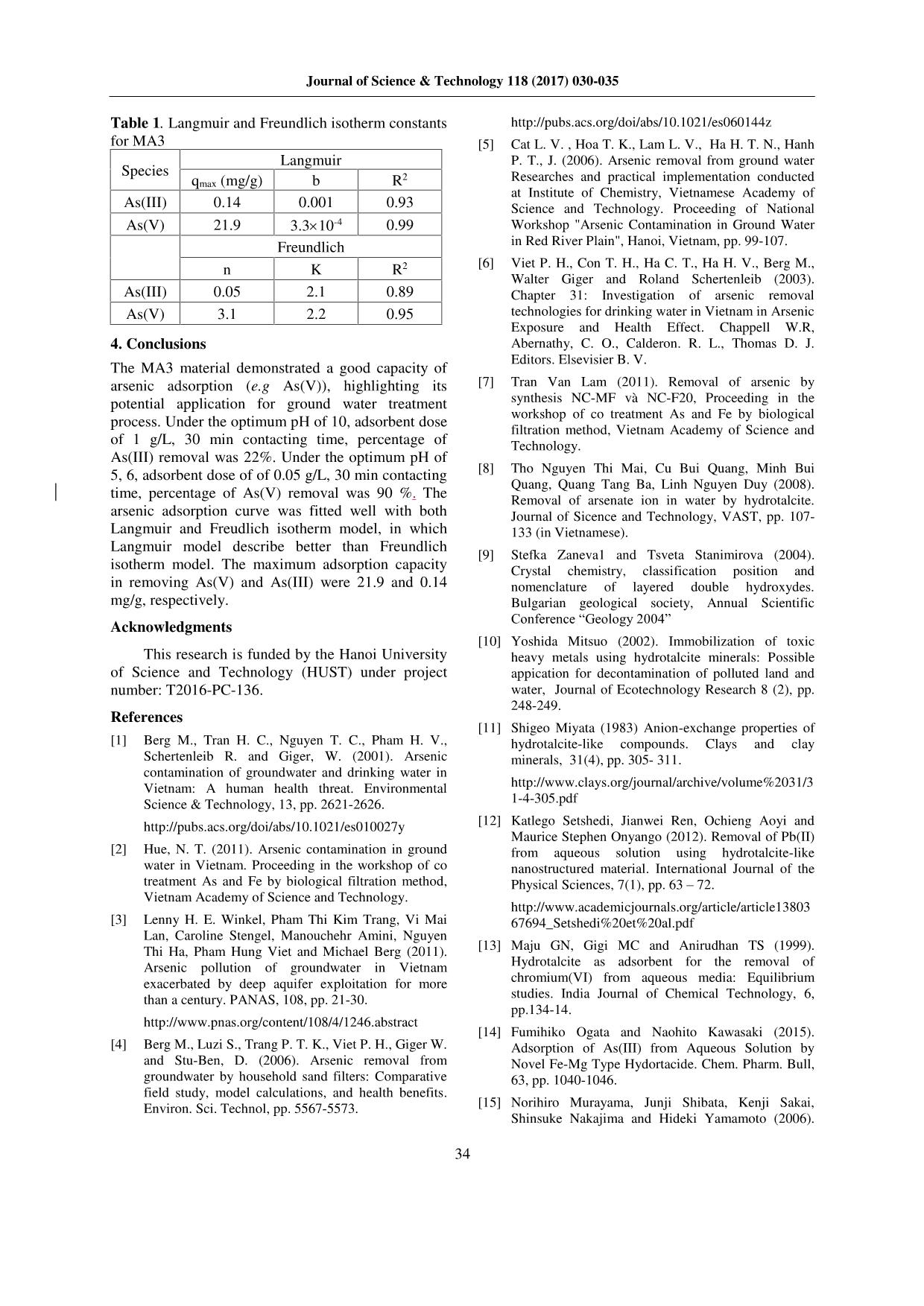
Trang 5
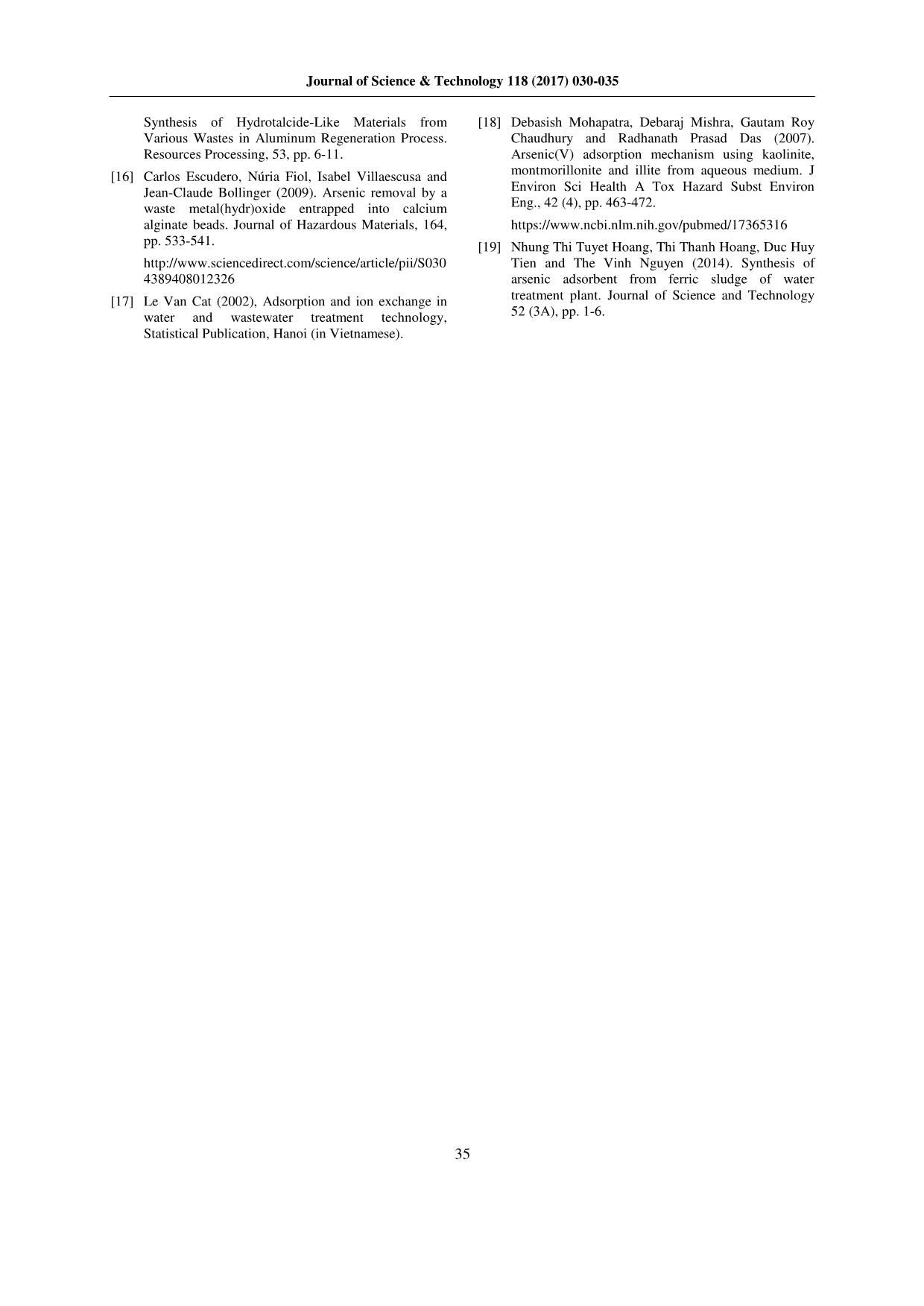
Trang 6
Tóm tắt nội dung tài liệu: Removal Efficiency of an Aluminum Based Hydrotalcite-Like-Compound on Arsenic
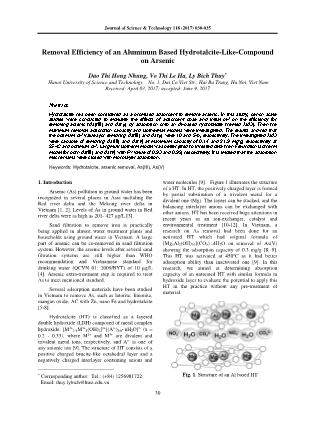
Journal of Science & Technology 118 (2017) 030-035 30 Removal Efficiency of an Aluminum Based Hydrotalcite-Like-Compound on Arsenic Dao Thi Hong Nhung, Vo Thi Le Ha, Ly Bich Thuy* Hanoi University of Science and Technology – No. 1, Dai Co Viet Str., Hai Ba Trung, Ha Noi, Viet Nam Received: April 03, 2017; accepted: June 9, 2017 Abstract Hydrotalcite has been considered as a promised adsorbent to remove arsenic. In this study, bench scale studies were conducted to evaluate the effects of adsorbent dose and initial pH on the efficiency for removing arsenic (As)(III) and As(V) by adsorption onto an Al-based hydrotalcite (named MA3). Then the maximum removal adsorption capacity and isothermal models were investigated. The results showed that the optimum pH values for removing As(III) and As(V) were 10 and 5-6, respectively. The investigated MA3 were capable of removing As(III) and As(V) at maximum capacity of 0.14 and 21.9 mg/g, respectively at 25 oC and optimum pH. Langmuir isotherm model was better fitted to invested data than Freundlich isotherm model for both As(III) and As(V) with R2 value of 0.93 and 0.99, respectively. It is implied that the adsorption mechanisms were closed with monolayer adsorption. Keywords: Hydrotalcite, arsenic removal, As(III), As(V) 1. Introduction* Arsenic (As) pollution in ground water has been recognized in several places in Asia including the Red river delta and the Mekong river delta in Vietnam [1, 2]. Levels of As in ground water in Red river delta were as high as 201- 427 μg/L [3]. Sand filtration to remove iron is practically being applied in almost water treatment plants and households using ground water in Vietnam. A large part of arsenic can be co-removed in sand filtration system. However, the arsenic levels after several sand filtration systems are still higher than WHO recommendation and Vietnamese standard for drinking water (QCVN 01: 2009/BYT) of 10 g/L [4]. Arsenic extra-treatment step is required to treat As to meet mentioned standard. Several adsorption materials have been studied in Vietnam to remove As, such as latorite, limonite, mangan oxide, AC with Zn, nano Fe and hydrotalcite [5-8]. Hydrotalcite (HT) is classified as a layered double hydroxide (LDH) composed of metal complex hydroxide: [M2+1-xM3+x(OH)2]x+[(An-)x/n nH2O]x- (x = 0.2 - 0.33), where M2+ and M3+ are divalent and trivalent metal ions, respectively, and An- is one of any anionic ion [9]. The structure of HT consists of a positive charged brucite-like octahedral layer and a negatively charged interlayer containing anions and * Corresponding author: Tel.: (+84) 1256981722 Email: thuy.lybich@hust.edu.vn water molecules [9]. Figure 1 illustrates the structure of a HT. In HT, the positively charged layer is formed by partial substitution of a trivalent metal for a divalent one (Mg). The layers can be stacked, and the balancing interlayer anions can be exchanged with other anions. HT has been received huge attentions in recent years as an ion-exchanger, catalyst and environmental treatment [10-12]. In Vietnam, a research on As removal had been done for an activated HT which had original formula of [Mg6Al2(OH)16](CO3).4H2O on removal of As(V) showing the adsorption capacity of 0.3 mg/g [8, 9]. This HT was activated at 450oC as it had better adsorption ability than inactivated one [9]. In this research, we aimed at determining absorption capacity of an untreated HT with similar formula in hydroxide layer to evaluate the potential to apply this HT in the practice without any pre-treatment of material. Fig. 1. Structure of an Al based HT Journal of Science & Technology 118 (2017) 030-035 31 2. Materials and Methods 2.1. Materials [Mg6Al2(OH)12]2+[NO3.CO3.zH2O]2- was obtained from Tomita Pharmaceutical Co., LTD. Analytical grade chemical were used to prepare for 1000 mg/L stock solution of As(III) and As(V). pH adjustment solution, HCl and NaOH 0.1 M, were prepared from analytical grade solution. 2.2. Batch experiments 2.2.1. Arsenic adsorption Batch adsorption experiments were carried to examine the affecting factors including adsorbent doses (0.05-1 g/L), pH (4-11) on arsenic uptake performance. The suitable adsorption doses were chosen to investigate for pH effect. Optimum pH value was applied for further experiments. The isothermal experiments were also carried out at optimum pH and at initial concentration of As(III) and As(V) ranged of 10 µg/L - 10 mg/L and of 20 µg/l - 230 mg/L, respectively. All these experiments were performed by using 100 mL glass conical flasks with 50 ml As solution shaken at 150 rpm within 30 min at 25 oC. The experiment period of 30 min was chosen from previous study that the equilibrium state could be fully obtained. 1M HCl or 1M NaOH solution was used to adjust pH. After the shaken period, solution was separated from material by filtration. All samples were prepared and analyzed in triplicate. The pHpzc determination [13] Batch equilibrium method was employed to measure pHpzc of MA3. The initial pH values were adjusted within the range of 2-12 using 0.1 M and 0.01 M NaCl, the dosage of MA3 was given 1 g/L for As(III) and 0.25 g/L for As(V). The mixtures were equilibrated for 24 hours, before the final pH values of solution were measured. The removal efficiency was calculated using equation (1): ( )(%) 100o t o C C Efficiency C (1) Where Co was the initial concentration arsenic in the feed and Ct was the concentration of arsenic at time t. 2.3. Analytic method Concentrations of As were analyzed by ICP-MS Perkin Elmer. 3. Results and disscution 3. 1. Effects of adsorbent dose on As(III) and As(V) removal rate The effects of adsorbent doses on As(III) and As(V) removal capability were examined. The results were presented in Figure 2. As(III) removal rate increased slowly and approached 17 % at the highest investigated dose of 1 g/L. As(V) removal efficiency increased rapidly with the increasing of MA3 dose to the criterial point around dose of 0.2 – 0.25 g/L that removal rate reached to 90 %. Thereafter a very slowly increasing was observed with the increasing of adsorbent dose. The up-trends can be explained by the fact that the availability of more sorption sites with an increment in the sorbent mass resulting on the increase in the As uptake. MA3 yielded low As(III) removal capacity, but it had a good affinity toward As(V). As(V) can be treated by MA3 from 50 μg/L to 5 μg/L, fully meet QCVN 01- 2009/BYT. The adsorbent doses of 0.25 and 1 g/L were used for further experiments for adsorbing As(V) and As(III), respectively. Those doses were chosen that the removal rate is high enough that the difference of removal rate corresponding with different pH can be well observed. Besides, the dose should not be so high after the criterial point that the unfavorite pH condition could be overcome by a high dose of adsorbent. Fig. 2. Effect of adsorbent dose on: a) As(III) removal (pH= 7, Co= 100 μg/L) b) As(V) removal (pH=7, Co = 50 μg/L) Journal of Science & Technology 118 (2017) 030-035 32 3.2. Effects of pH on As(III) and As(V) removal rate The effects of pH on As(III) and As(V) removal rates were presented in Figure 3. The removal rate of As(III) was more or less the same in the range of pH from 4 to 9. A peak of removal rate was obtained at pH from 9 to 11 with the tip at pH of 10. The removal rate at pH of 10 was more than 3 times higher than removal rate at plateaus area approaching 22 %. As(V) removal rate was varied moderately in the range of 60 % to 90 %. The removal efficiency of As(V) achieved the maximum percentage of 90 % at pH of 5-6. The highest removal percentage of activated HT for the investigated pH range of 6-11 was 11 [8]. The difference of optimum pH between inactivated and activated HT can mainly be explained because of the structure change of HT when be activated. Fig. 3. Effect of pH on: a) As(III) removal (adsorption dose = 1 mg/L, Co= 100 μg/L) b) As(V) removals (adsorption dose = 0.25 mg/L, Co = 50 μg/L) Regarding to the pHpzc values, the point of zero charge (PZC) of MA3 adsorbent was ranged from 6.5 to 7. When pH value was lower than the pHpzc, the adsorbent surface was more positively charged. In that pH range, H2AsO4- was the predominant As(V) species [7]. Therefore, a more amount of As(V) was adsorbed on the surface of MA3 due to the electrostatic attraction of surface and As(V). On the contrary, when the pH values were higher than pHpzc, the adsorbent surface was prevailing negatively charged. In that condition, a more amount of As(V) remained in the solution because of electrostatic repulsive forces between the negatively charged surface and As(V) compounds. Therefore As(V) removal rate was lower. These findings could be used to explain for the trend of adsorbate removal under the effect of pH. In case of As(III), at pH<pHPzc, MA3 surface was positive charged. However, at that pH range, As(III) occurred predominantly in neutral form (H3AsO3). Electrostatic force including Columbic attraction of repulsion between active sites and As species did not appear resulting in low removal rate of As(III). At pH from pHPzc to 9, the negative charge surface of MA3 also did not interact well with neutral form of As(III). However, when pH reached 10, As(III) in aqueous solution existed mainly in the form of H2AsO32-, ion-exchange reaction happened between H2AsO32- and CO32- inside MA3. Therefore, As(III) was removed the most effectively at the pH of 10. The As(III) removal trend decreased when pH reached 11. It was likely because of the competitive reaction between ion OH- and H2AsO32- in exchanging with ion CO32- leading to the less favorable adsorption condition for As(III) [14-16]. 3.3. Adsorption capacity of MA3 on As The Langmuir and Freundlich equations were used to describe the interaction between adsorbate and adsorbent. Those models can be represented as in the equation 2 and 3, respectively: max max 1 . e e e C C q q b q (2) 1ln ln lne eq K C n (3) where Ce is the equilibrium concentration of adsorbate in the solution, qe is quantity of As adsorbed at equilibrium, qmax is maximum adsorption capacity (monolayer capacity); b is Langmuir constant related to binding energy; K and 1/n are Freundlich constants related to adsorption capacity and adsorption intensity, respectively [17]. In Figure 4 and Figure 5, isothermal curves and Langmuir and Freudlich graphs of As(III) and As(V) were presented, respectively. Both Langmuir and Freundlich models fitted reasonably well with the experiment data. Langmuir isotherm model had correlation coefficient (R2) = 0.93 and 0.99 for Journal of Science & Technology 118 (2017) 030-035 33 Fig. 4. Interaction between MA3 and As(III): a) Isothermal curve, b) Langmuir isothermal equation, c) Freundlich isothermal equation at pH = 10, adsorbent dose = 1 mg/L. As(III) and As(V), respectively, could describe the isotherm better than the Freundlich isotherm model (R2 = 0.88 and 0.91). It implied that the adsorption processes were closer with monolayer adsorption than non-specific adsorption on herterotrophic surface. The maximum adsorption capacities of MA3 for As(III) and As(V) varied from 0.14 to 21.9 mg/g, higher than adsorption capacities of other materials for As(V) such as latorite of 1.1 and limonite of 0.9 [6] illite of 0.52, kaolinite of 0.86, montmorillonite [18], synthesis material from ferric sludge of 0.024 mg/g [19] and activated HT of 0.3 mg/g [8]. The maximum adsoption capacity of MA3 was much higher than the activated HT in research of Tho et al. [8] because the adsorption of activated HT was done at Co = 330 g/L much lower than the range of As(V) investigated in this research. Comparing with adsorption capacity of MA3 at Co=100 g/L, adsorption dose of 0.05 g/L, pH = 7 a same range adsorption capacity of 0.38 mg/g was obtained (Figure 2b). Fig. 5. Interaction between MA3 and As(V): a) Isothermal curve, b) Langmuir isotherm equation, c) Freundlich isotherm equation at pH = 6, adsorbent dose = 0.25 mg/L Journal of Science & Technology 118 (2017) 030-035 34 Table 1. Langmuir and Freundlich isotherm constants for MA3 Species Langmuirqmax (mg/g) b R2 As(III) 0.14 0.001 0.93 As(V) 21.9 3.3 10-4 0.99 Freundlich n K R2 As(III) 0.05 2.1 0.89 As(V) 3.1 2.2 0.95 4. Conclusions The MA3 material demonstrated a good capacity of arsenic adsorption (e.g As(V)), highlighting its potential application for ground water treatment process. Under the optimum pH of 10, adsorbent dose of 1 g/L, 30 min contacting time, percentage of As(III) removal was 22%. Under the optimum pH of 5, 6, adsorbent dose of of 0.05 g/L, 30 min contacting time, percentage of As(V) removal was 90 %. The arsenic adsorption curve was fitted well with both Langmuir and Freudlich isotherm model, in which Langmuir model describe better than Freundlich isotherm model. The maximum adsorption capacity in removing As(V) and As(III) were 21.9 and 0.14 mg/g, respectively. Acknowledgments This research is funded by the Hanoi University of Science and Technology (HUST) under project number: T2016-PC-136. References [1] Berg M., Tran H. C., Nguyen T. C., Pham H. V., Schertenleib R. and Giger, W. (2001). Arsenic contamination of groundwater and drinking water in Vietnam: A human health threat. Environmental Science & Technology, 13, pp. 2621-2626. [2] Hue, N. T. (2011). Arsenic contamination in ground water in Vietnam. Proceeding in the workshop of co treatment As and Fe by biological filtration method, Vietnam Academy of Science and Technology. [3] Lenny H. E. Winkel, Pham Thi Kim Trang, Vi Mai Lan, Caroline Stengel, Manouchehr Amini, Nguyen Thi Ha, Pham Hung Viet and Michael Berg (2011). Arsenic pollution of groundwater in Vietnam exacerbated by deep aquifer exploitation for more than a century. PANAS, 108, pp. 21-30. [4] Berg M., Luzi S., Trang P. T. K., Viet P. H., Giger W. and Stu-Ben, D. (2006). Arsenic removal from groundwater by household sand filters: Comparative field study, model calculations, and health benefits. Environ. Sci. Technol, pp. 5567-5573. [5] Cat L. V. , Hoa T. K., Lam L. V., Ha H. T. N., Hanh P. T., J. (2006). Arsenic removal from ground water Researches and practical implementation conducted at Institute of Chemistry, Vietnamese Academy of Science and Technology. Proceeding of National Workshop "Arsenic Contamination in Ground Water in Red River Plain", Hanoi, Vietnam, pp. 99-107. [6] Viet P. H., Con T. H., Ha C. T., Ha H. V., Berg M., Walter Giger and Roland Schertenleib (2003). Chapter 31: Investigation of arsenic removal technologies for drinking water in Vietnam in Arsenic Exposure and Health Effect. Chappell W.R, Abernathy, C. O., Calderon. R. L., Thomas D. J. Editors. Elsevisier B. V. [7] Tran Van Lam (2011). Removal of arsenic by synthesis NC-MF và NC-F20, Proceeding in the workshop of co treatment As and Fe by biological filtration method, Vietnam Academy of Science and Technology. [8] Tho Nguyen Thi Mai, Cu Bui Quang, Minh Bui Quang, Quang Tang Ba, Linh Nguyen Duy (2008). Removal of arsenate ion in water by hydrotalcite. Journal of Sicence and Technology, VAST, pp. 107- 133 (in Vietnamese). [9] Stefka Zaneva1 and Tsveta Stanimirova (2004). Crystal chemistry, classification position and nomenclature of layered double hydroxydes. Bulgarian geological society, Annual Scientific Conference “Geology 2004” [10] Yoshida Mitsuo (2002). Immobilization of toxic heavy metals using hydrotalcite minerals: Possible appication for decontamination of polluted land and water, Journal of Ecotechnology Research 8 (2), pp. 248-249. [11] Shigeo Miyata (1983) Anion-exchange properties of hydrotalcite-like compounds. Clays and clay minerals, 31(4), pp. 305- 311. 1-4-305.pdf [12] Katlego Setshedi, Jianwei Ren, Ochieng Aoyi and Maurice Stephen Onyango (2012). Removal of Pb(II) from aqueous solution using hydrotalcite-like nanostructured material. International Journal of the Physical Sciences, 7(1), pp. 63 – 72. 67694_Setshedi%20et%20al.pdf [13] Maju GN, Gigi MC and Anirudhan TS (1999). Hydrotalcite as adsorbent for the removal of chromium(VI) from aqueous media: Equilibrium studies. India Journal of Chemical Technology, 6, pp.134-14. [14] Fumihiko Ogata and Naohito Kawasaki (2015). Adsorption of As(III) from Aqueous Solution by Novel Fe-Mg Type Hydortacide. Chem. Pharm. Bull, 63, pp. 1040-1046. [15] Norihiro Murayama, Junji Shibata, Kenji Sakai, Shinsuke Nakajima and Hideki Yamamoto (2006). Journal of Science & Technology 118 (2017) 030-035 35 Synthesis of Hydrotalcide-Like Materials from Various Wastes in Aluminum Regeneration Process. Resources Processing, 53, pp. 6-11. [16] Carlos Escudero, Núria Fiol, Isabel Villaescusa and Jean-Claude Bollinger (2009). Arsenic removal by a waste metal(hydr)oxide entrapped into calcium alginate beads. Journal of Hazardous Materials, 164, pp. 533-541. 4389408012326 [17] Le Van Cat (2002), Adsorption and ion exchange in water and wastewater treatment technology, Statistical Publication, Hanoi (in Vietnamese). [18] Debasish Mohapatra, Debaraj Mishra, Gautam Roy Chaudhury and Radhanath Prasad Das (2007). Arsenic(V) adsorption mechanism using kaolinite, montmorillonite and illite from aqueous medium. J Environ Sci Health A Tox Hazard Subst Environ Eng., 42 (4), pp. 463-472. https://www.ncbi.nlm.nih.gov/pubmed/17365316 [19] Nhung Thi Tuyet Hoang, Thi Thanh Hoang, Duc Huy Tien and The Vinh Nguyen (2014). Synthesis of arsenic adsorbent from ferric sludge of water treatment plant. Journal of Science and Technology 52 (3A), pp. 1-6.
File đính kèm:
 removal_efficiency_of_an_aluminum_based_hydrotalcite_like_co.pdf
removal_efficiency_of_an_aluminum_based_hydrotalcite_like_co.pdf

